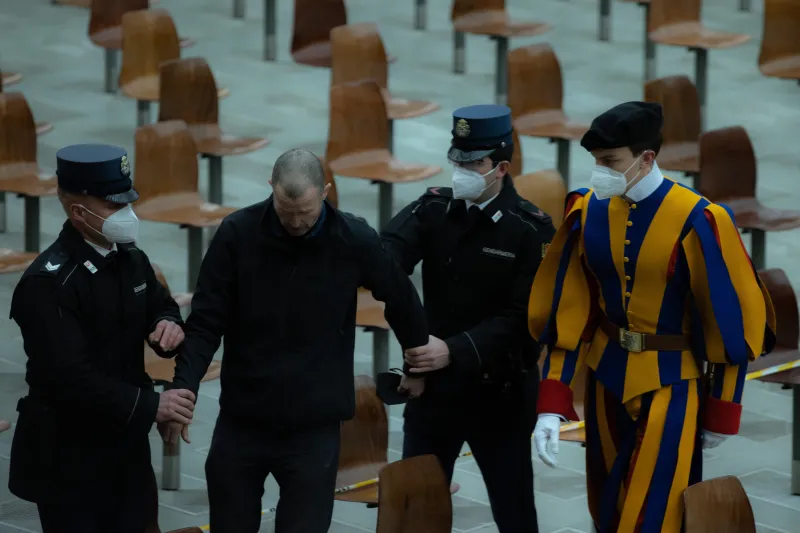
Rome Newsroom, Jul 20, 2022 / 03:55 am (CNA).
With speculation running rife whether Pope Francis could resign, and whether he might retire to a residence in the Vatican Gardens like Benedict XVI, it is worth analyzing what the pope has actually said — and how this aligns with his wider project of a reform for the Roman Curia and the Catholic Church.
Speaking with the Mexican television company Televisa, Pope Francis has made it known, once again, that he does not intend to give up the Petrine ministry. If and when he does though, he would not take the title of Pope Emeritus.
Instead, Francis would become Bishop Emeritus of Rome. He would hear confessions and dedicate himself to the poor.
Where Benedict and Francis think differently
His recent comments suggest Pope Francis might go to live in the Lateran Palace, which is the seat of the pope as Bishop of Rome.
In this interview, Pope Francis also discussed –– in clear terms –– how he thinks the office of Pope Emeritus should be defined and how he would interpret his own role after a possible renunciation.
Pope Francis’ conception of the office differs from that of his predecessor: Benedict XVI decided to take the title of Pope Emeritus, to continue wearing white, although without la pellegrina, which is the white mantle symbolizing episcopal authority.
Benedict XVI defined the terms of his resignation in his last general audience as Pope on February 27, 2013: “There can no longer be a return to the private sphere. My decision to resign the active exercise of the ministry does not revoke this. I do not return to private life, to a life of travel, meetings, receptions, conferences, and so on. I am not abandoning the cross, but remaining in a new way at the side of the crucified Lord. ”
Does one stay pope forever?
In practice, Benedict XVI distinguished between the munus and the officium, that is, between the function and the exercise of the function. Once elected pope, he remains pope forever.
In a certain sense, Benedict XVI equated the election as pope with a further episcopal ordination. The theologian Karl Rahner, who emphasized that the power of order and the power of jurisdiction were indissociable, had come to consider the primacy conferred with the election as Pope as the highest degree of the sacrament of orders. According to this criterion, the beginning of the Pope’s Petrine ministry would represent a unique ordination.
Pope Francis, however, plans to be Bishop of Rome Emeritus. He would no longer have the Petrine primacy and therefore would return to work in public life as a confessor, and likely also reside in the Lateran Palace.
This role was outlined by Father Gianfranco Ghirlanda, canonist and cardinal to be elected at the next consistory, in an essay from 2013 republished by Civiltà Cattolica.
Seeking a reform that works
Ghirlanda’s essay offers many observations on the role of a pope emeritus, starting with the fact that ordination and authority are distinct from one another. The issue is a fundamental one, and came up during the reform of the Roman Curia when lay people were allowed to take up positions in the Curia departments.
If that is the standard, episcopal ordination is no longer a prerequisite for authority, much less collegiality with the Pope, who is also a bishop.
In his statements, Pope Francis seems to be intending not to separate munus and officium. One ceases with the cessation of the other, and whoever renounces them returns to their previous life.
Will this be the reform that is announced for the office of Pope Emeritus? It is possible, certainly. The extent to which a Bishop of Rome Emeritus can influence the life of the Church will also require definition. By the admission of Pope Francis himself, everything in recent years has worked for the extraordinary character of Benedict XVI. But would it work the same with another pope emeritus?
If you value the news and views Catholic World Report provides, please consider donating to support our efforts. Your contribution will help us continue to make CWR available to all readers worldwide for free, without a subscription. Thank you for your generosity!
Click here for more information on donating to CWR. Click here to sign up for our newsletter.






“If that is the standard, episcopal ordination is no longer a prerequisite for authority, much less collegiality with the Pope, who is also a bishop.”
A premise that should have been addressed and determined in council, not decided unilaterally.
Pope Francis has it right. It is the Bishop of Rome who also holds the title Pope, so if he does retire then he should be known as Bishop Emeritus.
I’m getting the impression that if he resigned, we would still have to listen to his continuous absurdities.